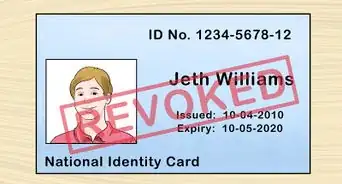This article was co-authored by Clinton M. Sandvick, JD, PhD. Clinton M. Sandvick worked as a civil litigator in California for over 7 years. He received his JD from the University of Wisconsin-Madison in 1998 and his PhD in American History from the University of Oregon in 2013.
There are 26 references cited in this article, which can be found at the bottom of the page.
wikiHow marks an article as reader-approved once it receives enough positive feedback. This article received 13 testimonials and 94% of readers who voted found it helpful, earning it our reader-approved status.
This article has been viewed 453,047 times.
Canada has a vibrant economy, beautiful natural scenery, and a rich history. It is no wonder that many U.S. citizens are considering how to immigrate to Canada. There are several types of immigration programs you can apply through to gain permanent residency in Canada. You just have to know which ones will be best for your situation, and be patient in the process.
Steps
Determining Your Eligibility and Options
-
1Decide why you want to move there. U.S. citizens are not required to obtain any sort of visa or authorization to visit Canada, but this is not the case for immigrating to Canada.[1] You must have permission to reside in Canada through one of several sources. You should have one of the following reasons for living in Canada:[2]
- A skill that can be used in Canadian businesses
- A job waiting for you in Canada
- Relatives or friends who have nominated you for permanent residency
- Be an entrepreneur with a high net worth
-
2Choose a destination province. Once you have selected a valid reason for immigrating to Canada, you must choose a province to live in. Each province (which is like a state in the USA) has its own rules about immigration. They also each have their own immigration programs which you may apply for.[3]
- Some provinces have a higher need for skilled workers than others, for example.
Advertisement -
3Read the immigration rules of your province. After selecting your province, look on their website to determine their particular immigration rules. You must make sure that you select the proper immigration program and do all the follow-up work to become a permanent resident.
- For example, in British Columbia (BC), you can apply through a relative who has nominated you but you can also do an “express entry” through this nomination that expedites your permanent residency if you are a skilled worker.[4]
-
4Determine if you fulfill the eligibility requirements. Canada has a variety of immigration programs, and each of them have their own eligibility requirements. You can take a questionnaire to determine how eligible you are on the Canadian government website.[5]
- Eligibility is based on a lot of different features, such as age, nationality, if you have family members residing in Canada, your education and work experience, your income or net worth, whether or not you have a Canadian job offer, and so on.
- The government questionnaire asks you questions about each of these elements.
-
5Avoid things that will reduce your chances. There are particular things about your personal history that may result in a guaranteed rejection of your permanent residency application. Find out if you have any of these elements on your record before pursuing immigration to Canada.[6]
- For example, applications are often automatically rejected if you have ever perpetrated a crime, have a serious health risk, are in financial trouble, or if one of your family members has already been barred from Canada.
Choosing an Immigration Program
-
1Evaluate the immigration programs. Take a close look at the immigration programs available in Canada. This is important so that you can select the program that will make it easiest for you to gain permanent residency. In other words, look at the program most suited to your situation.
-
2Look at Express Entry. Express Entry is a program for skilled workers to immigrate quickly. It is entirely internet-based, making it convenient for Canadian employers to get their new hires into the country.[7] This program is available for anyone immigrating to Canada who has a job lined up.
-
3Determine if you are a skilled worker. Skilled Worker immigration has three levels: federal, Quebec, and provincial nominee programs (PNPs). Each program admits people with specific work qualifications or needs of the province.[8]
- Federal Skilled Worker is for people who have work experience and want to live outside of Quebec.
- Quebec Skilled Worker is for people with work experience who want to live inside Quebec.
- PNPs are typically unique to each province and allow skilled workers to immigrate more quickly than other programs.
-
4Consider CEC if you have worked in Canada before. Canadian Experience Class (CEC) is a program available to U.S. citizens (and other foreign workers) currently working and living in Canada who have proven their value to society and the economy.[9]
- Basically, this program is for people who have already worked in Canada as temporary foreign workers.
- This program is convenient for those who are already inside Canada, have been working there, and have decided to reside there permanently (longer than a year).
-
5Decide if you want to live in Quebec. Quebec Experience Class (PEQ) is unique to the Quebec province and is applicable to students and workers wishing to gain permanent residency in Quebec. It is a two-step process.[10]
- This is essentially the same program as CEC, but for Quebec.
-
6Contact any friends or family. If you have immediate relatives already living in Canada, the Family Class Sponsorship program is a good way to immigrate without worrying about having a job. Although usually restricted to grandparents, parents, children, and spouses (or common law partners), sometimes exceptions are made by the Canadian government.[11]
- Some individual provinces are more lenient about what family members are allowed to immigrate. Investigate the Provincial Nominee Program’s Family Sponsorship program in the province where your relative lives.[12]
-
7Determine if you want to start a business. A program called the Start-Up Visa Program allows entrepreneurs with specific business offerings (namely that they will create jobs for Canadians) to immigrate. You don’t even have to already have your business started. Simply get support for your idea and apply for the Start-Up Visa.[13]
- You can find support for your business idea through Canadian investor groups and capital funds.[14]
-
8See if anyone needs caretaking. There is also a program that allows you to immigrate if you are needed to take care of children, the elderly, or an injured person who otherwise would have no assistance. The rules on this program are somewhat strict and require a lot of paperwork.[15]
- Some things you must have in place to obtain this LCP (live-in caregivers) permit include an employer assessment, a written contract, a work permit, a high school diploma, and at least 6 months of training (or one year paid work experience) as a caregiver.
Preparing for Your New Life
-
1Pass the Canadian language test. A language test is required for immigrating to Canada. You can test for either English or French. There are two English tests you can choose from, and one French test. You must make a specific score set by the Canadian government in order to apply for permanent residency or citizenship.[16]
- The IELTS (International English Language Testing System) has 5 sections: CBL (Canadian Language Benchmarks) level, reading, writing, listening, and speaking.[17]
- CELPIP (Canadian English Language Proficiency Index Program) has two versions, one for permanent residency and one for citizenship.[18]
- The French test is called TEF (Test d’évaluation de français) and is only available in French.
-
2Apply for a permanent visa. While you are still living in the USA, you should go ahead and apply for permanent residency in Canada. Make sure you have chosen the immigration program most suited to your situation. Give yourself enough time. It can take anywhere from 2 months to a year for applications to be approved.[19]
- You may get a faster approval if you and your employer apply through the Express Entry immigration program.[20]
- If you are already working in Canada and are considered a temporary foreign worker, you may gain permanent residency through the Canadian Experience Class (CEC). This only applies to workers outside of Quebec. You should apply through the Express Entry system.[21]
- You can apply for the Quebec Experience Class (PEQ) to work inside Quebec.
- You will need to check the immigration website for Canada to gather all the necessary forms.[22]
-
3Save up. It is wise to have nest egg ready for your move to Canada, even if you are being brought in by an employer. You never know what obstacles you will face on your way to Canada, or what complications and delays may arise once you get there.[23]
- Set aside money from your income in the USA while you wait for your Canadian permanent visa to be approved.
-
4Visit Canada to work or study. Before deciding to move to Canada, it is wise to visit there either through studying abroad or working as a temporary foreign worker. Not only does this allow you to become familiar with Canada and help you decide if you want to permanently relocate there, but prior work experience in the country may help your immigration process.
- Some jobs do not require a work permit if you are temporarily working in Canada, such as an athletic coach, clergyman, or a convention organizer.[24]
-
5Make friends there. Even if you already have relatives waiting for you in Canada, it is smart to start making friends either before you move or as soon as you arrive. Having people you can talk to will help you minimize culture shock and homesickness.
- Look on Facebook for groups in the area you are trying to move to, or ask your online friends if they know anyone in the area.[25]
-
6Apply for citizenship. Once you have lived in Canada for 4 out of 6 years after receiving your permanent residency, you may apply to be a citizen. You have to be at least 18 years old, prove that you are fluent in either English or French, be current with taxes, and declare that you intend to live in Canada permanently.[26]
- You must also be present in Canada for 183 days out of each of those 4 years.
- You have to apply for citizenship inside Canada.
- Your application may be expedited if you were ever a member of the Canadian Armed Forces.
Warnings
- Your application for permanent residency will most likely be denied if any of the following are true:[30]
- you fail to meet the conditions of Canada’s immigration laws,
- you have a health problem that is very serious,
- you have a serious financial problem (such as bad credit),
- you lied in the application process,
- one of your family members is not allowed into Canada,
- you're a risk for security,
- you've violated international or human rights,
- you have ever been convicted of a crime, or
- you have ties to mafia, gangs, or other organized crime.
⧼thumbs_response⧽
References
- ↑ http://www.cic.gc.ca/ctc-vac/getting-started.asp
- ↑ http://www.canadavisa.com/canadian-immigration-visas.html
- ↑ https://www.welcomebc.ca/Immigrate-to-B-C
- ↑ https://www.welcomebc.ca/Immigrate-to-B-C/BC-PNP-Express-Entry-B-C
- ↑ http://www.cic.gc.ca/ctc-vac/getting-started.asp
- ↑ http://www.cic.gc.ca/english/information/inadmissibility/index.asp
- ↑ http://www.canadavisa.com/express-entry.html
- ↑ http://www.canadavisa.com/canada-skilled-worker-immigration.html
- ↑ http://www.canadavisa.com/canadian-experience-class.html
- ↑ http://www.canadavisa.com/quebec-experience-class-canadian-immigration.html
- ↑ http://www.canadavisa.com/canadian-family-sponsorship-visa.html
- ↑ http://www.canadavisa.com/pnp-family-class-immigration.html
- ↑ http://www.cic.gc.ca/english/immigrate/business/start-up/index.asp?utm_source=slash-startup&utm_medium=short-url&utm_campaign=generic
- ↑ http://www.cic.gc.ca/english/immigrate/business/start-up/eligibility/entities.asp
- ↑ http://www.cic.gc.ca/english/work/caregiver/index.asp
- ↑ http://www.cic.gc.ca/english/immigrate/skilled/language-testing.asp
- ↑ https://www.ielts.org/what-is-ielts/ielts-for-migration/canada
- ↑ https://www.celpip.ca/take-celpip/overview/
- ↑ http://www.cic.gc.ca/english/information/times/index.asp
- ↑ http://www.canadavisa.com/express-entry.html
- ↑ http://www.canadavisa.com/express-entry.html
- ↑ http://www.cic.gc.ca/english/information/applications/index.asp/
- ↑ http://apairandasparediy.com/2014/10/8-tips-for-moving-to-another-country-before-you-go.html
- ↑ http://www.cic.gc.ca/english/work/apply-who-nopermit.asp
- ↑ http://apairandasparediy.com/2014/10/8-tips-for-moving-to-another-country-before-you-go.html
- ↑ http://settlement.org/ontario/immigration-citizenship/citizenship/apply-for-canadian-citizenship/how-do-i-apply-for-canadian-citizenship/
- ↑ http://www.livingabroadincanada.com/getting-started/retirement/
- ↑ http://correresmidestino.com/how-much-does-immigrating-to-canada-cost/
- ↑ http://www.cic.gc.ca/english/citizenship/rules/index.asp
- ↑ http://www.cic.gc.ca/english/information/inadmissibility/index.asp
About This Article
To immigrate to Canada from the USA, look into Canada's immigration programs to see if you meet the eligibility requirements, since you'll usually need to secure a job in order to move there. If you have immediate relatives living in Canada, the Family Class Sponsorship program is a good way to immigrate without worrying about having a job. After choosing the immigration program best suited to your situation, apply for a permanent visa! For more helpful tips on choosing the right immigration program for you, read on!


















































































